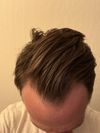community Update 1 year and 4 months into medication
The user has been using 1 mg of finasteride since February 2023 and started 2.5 mg of minoxidil at the beginning of the year, and is happy with the improvement in hair loss after 1 year and 4 months of treatment. They are 36 years old and noticed their hair thinning one year ago.
